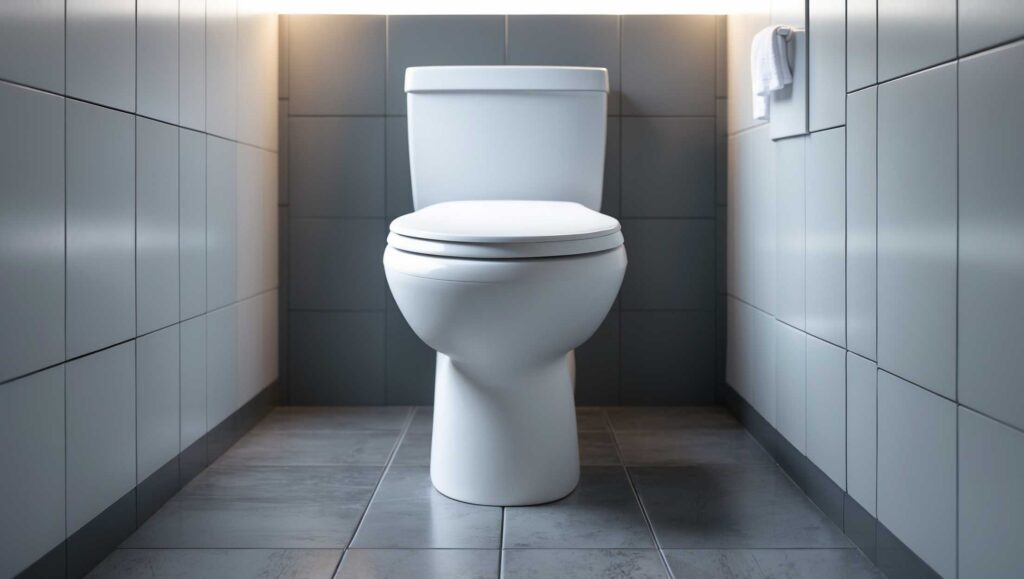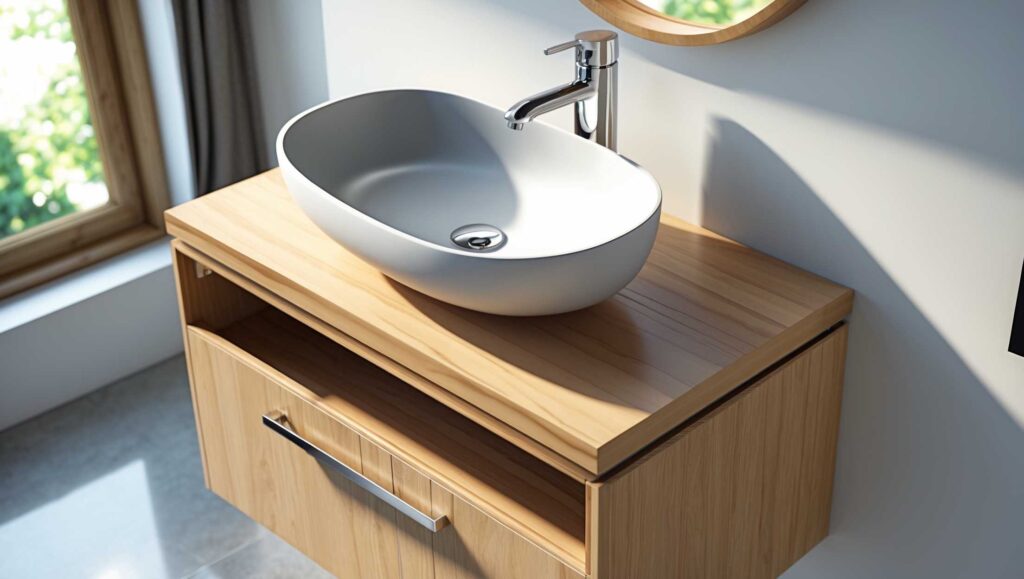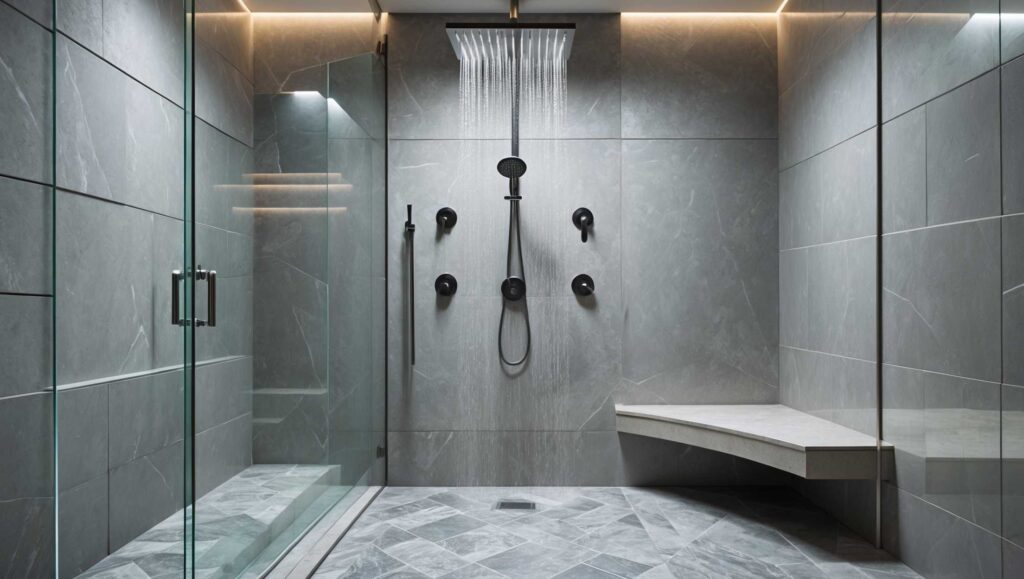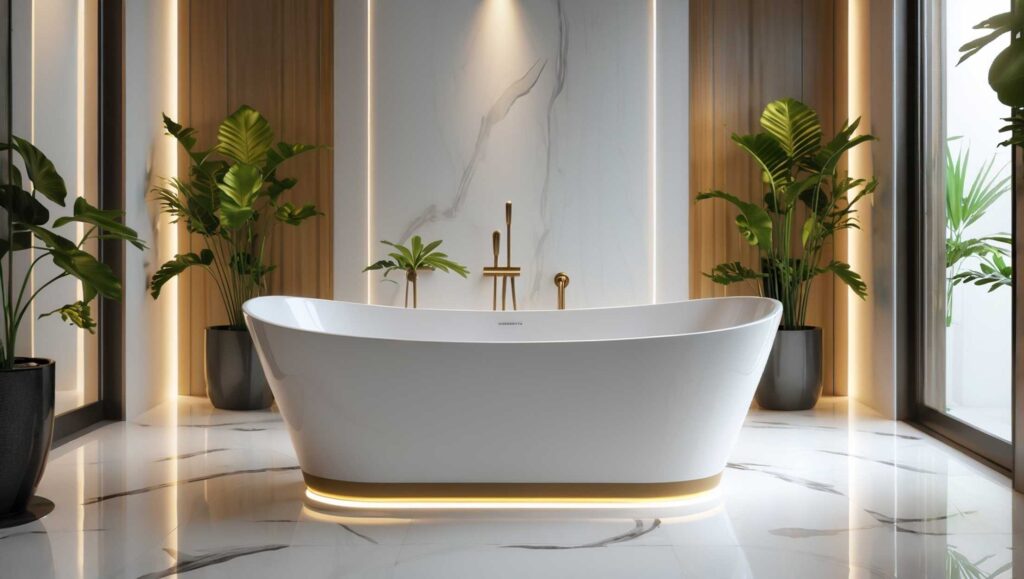Here we have shown standard bathroom height of all bathroom fixtures. When designing a bathroom, one of the most important considerations is ensuring that the height of your fixtures and fittings is just right. This ensures a functional, comfortable, and aesthetically pleasing space.
But what exactly are the standard bathroom heights, and why do they matter? We will answer all question in detail.
Standard Bathroom Heights for Different Fixtures
Table of Contents
Standard Height of Plumbing Fixtures
Toilet Height
When it comes to toilets, the standard height is typically between 15 and 16 inches from the floor to the seat. However, there’s also the option of comfort height toilets, which are around 17 to 19 inches high. These are more convenient for people with mobility challenges or those who prefer a higher seating position.

- Standard height: 15 inches (38 cm) from the floor to the top of the toilet seat.
- Comfort height: 17 to 19 inches (43 to 48 cm).
Sink Height
The standard sink height tends to be around 32 to 36 inches from the floor to the top of the basin. However, for bathroom vanities, the height might be a bit taller, ranging from 34 to 36 inches. For children’s bathrooms, you might opt for a sink height as low as 24 inches.

- Standard height: 32 to 36 inches (81 to 91 cm) from the floor to the top of the sink.
- Comfort height: Around 36 inches (91 cm).
Shower Height
Shower heads typically sit between 72 and 80 inches above the floor, but this can vary depending on the height of the users. For those who are taller, consider adjusting the shower head to provide optimal water flow.

- Showerhead: 72 to 80 inches (183 to 203 cm) from the floor.
- Shower Controls: 38 to 48 inches (97 to 122 cm) from the floor.
Diverter Height
The standard height for a bathroom diverter, which is used to switch water flow between a showerhead and a tub spout (or hand shower), is generally:
Diverter Height: 38 to 48 inches (97 to 122 cm) from the floor.
Bathtub Height
Standard bathtubs are usually between 14 to 16 inches high from the floor to the rim. However, if you’re installing a freestanding tub or a luxury soaking tub, the height might range from 18 to 22 inches.

Bathtub Faucet: Typically installed 2 to 4 inches above the rim of the bathtub.
Accessories and Fittings:
Towel Bars/Rings:
- Towel bar: 42 to 48 inches (107 to 122 cm) from the floor.
- Towel ring: 50 to 52 inches (127 to 132 cm) from the floor.
Toilet Paper Holder:
- Height: 26 inches (66 cm) from the floor.
- Distance from toilet: 8 to 12 inches (20 to 30 cm) in front of the toilet.
Soap Dish/Dispenser:
If wall-mounted: 44 to 54 inches (112 to 137 cm) from the floor, or within easy reach of the sink.
Grab Bars (for accessibility):
33 to 36 inches (84 to 91 cm) from the floor, depending on the specific location and use. These should be installed according to ADA guidelines for accessible bathrooms.
Robe Hooks: 65 to 70 inches (165 to 178 cm) from the floor.
Other Elements:
Mirror:
- Bottom edge: A few inches above the sink backsplash.
- Considerations: Large enough for comfortable reflection.
Medicine Cabinet:
Bottom edge: Typically aligned with the top of the mirror or slightly above.
Lighting:
- Overhead lighting: At least 80 inches (203 cm) above the floor.
- Sconces or vanity lighting: Placed at eye level or slightly above, flanking the mirror.
Why Standard Bathroom Height Matters
- Ergonomics and Comfort
Imagine trying to use a bathroom fixture that’s either too high or too low for you—it wouldn’t be comfortable, right? Standard bathroom heights are designed to optimize comfort for most people, helping to avoid unnecessary strain while using fixtures like the toilet, sink, and shower.
2. Accessibility Considerations
Standard bathroom height also ensures that spaces are accessible to a wider range of people. This includes individuals with mobility challenges or disabilities, and is a key element in creating an inclusive space.
3. Aesthetic Appeal
When everything in your bathroom aligns well, it not only functions better but looks more balanced. A bathroom with well-thought-out heights can contribute to an overall polished and cohesive design.
Factors to Consider When Determining Bathroom Heights
User Height and Accessibility
While the standard bathroom height suits most people, it’s important to consider the height of your household members or users. Taller individuals may benefit from higher fixtures, while shorter individuals might need lower heights for ease of use.
Design and Layout
Your bathroom design can influence fixture heights. For instance, a master bathroom may require more customized heights for a luxury feel, while a guest bathroom might work well with standard setups.
Type of Bathroom (Master, Guest, Powder Room)
Different types of bathrooms will have different fixture needs. A powder room may not require high-placed fixtures, while a master bathroom might call for more ergonomic solutions.
Adjusting Bathroom Heights for Accessibility
ADA Guidelines for Bathroom Fixtures
The Americans with Disabilities Act (ADA) offers guidelines to ensure that bathrooms are accessible to individuals with disabilities. These standards include recommended heights for toilets, sinks, and grab bars. For instance, a toilet height of 17 to 19 inches is considered ideal for accessibility.
Customizing Bathroom Height for Seniors and Disabled Individuals
In homes where there are seniors or people with mobility issues, customizing the bathroom height is crucial. This could mean installing grab bars at specific heights, lowering sinks, or opting for comfort height toilets.
Tips for Choosing the Right Bathroom Height
Measuring and Planning Before Installation
Before installing bathroom fixtures, take accurate measurements of the space and consider the people who will be using the bathroom. Make sure that the height of sinks, toilets, and other fixtures fits the needs of your household.
Consideration of Bathroom Size and Space
The overall layout of your bathroom can also affect how high or low fixtures should be. In smaller bathrooms, a more compact design might require fixtures to be positioned slightly lower or higher for better space efficiency.
Common Bathroom Height Mistakes to Avoid
Installing Fixtures Too High or Too Low
One of the most common mistakes is getting the height wrong when installing bathroom fixtures. If something is too high or too low, it can lead to discomfort and a lack of usability. Always stick to the recommended standards, or make adjustments based on specific needs.
Ignoring User Comfort
It’s essential to factor in the comfort of the users in your household. Everyone’s needs are different, so it’s worth considering whether certain adjustments would make a better fit for your home.
Conclusion
The height of your bathroom fixtures is more than just a design choice. It affects the comfort, accessibility, and aesthetic appeal of the space. By understanding standard bathroom heights and considering the needs of everyone who will be using the bathroom, you can create a more functional and comfortable environment.
FAQs
What is the best toilet height for comfort?
The best toilet height for comfort is usually between 17 to 19 inches, which is classified as comfort height. It’s more ergonomic for most adults, especially those with mobility concerns.
How high should a bathroom sink be for children?
For children, the ideal sink height is between 24 and 28 inches, which allows them to easily reach the faucet.
Can bathroom heights be customized?
Yes, bathroom heights can be customized depending on the user’s height, mobility needs, or personal preferences.
What is the ideal shower head height for most people?
A standard shower head height ranges between 72 to 78 inches, but taller individuals may prefer it higher.
Are there standard heights for bathroom vanities?
Bathroom vanities typically range from 34 to 36 inches in height, though lower options are available for children or specific needs.
What is the recommended height for a bathroom mirror?
The ideal height for a bathroom mirror is typically around 60 to 65 inches from the floor to the center of the mirror. This ensures it’s at eye level for most users.
Should I adjust the height of my bathroom fixtures for a tall person?
Yes, for taller individuals, you may want to adjust the height of fixtures like the toilet, sink, and shower head. Consider a higher toilet seat (comfort height) and a raised showerhead to accommodate their height comfortably.
What is the standard height for a bathroom towel bar?
The standard height for a bathroom towel bar is generally around 48 inches from the floor, making it easily accessible for most users. However, you can adjust this based on your household’s needs.
Can bathroom height affect resale value?
Yes, a well-designed bathroom with standard or adjustable heights can positively impact the resale value of a home. Buyers appreciate bathrooms that are functional and comfortable for all types of users.
How high should a bathroom light fixture be mounted?
Bathroom light fixtures are typically mounted 75 to 80 inches above the floor, depending on the size of the room. The goal is to ensure adequate lighting without creating shadows or glare for users.